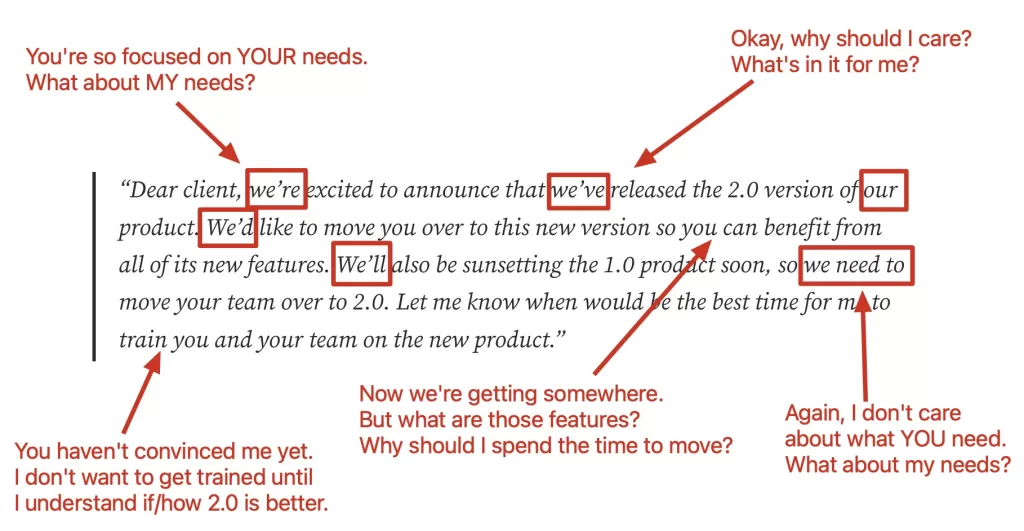The Secret Power of WIIFM
Eight years ago, I was tasked with converting some of our company’s oldest, stubbornest clients to upgrade from our old “1.0” software-as-a-service (SaaS) product to what my friends and I jokingly called the “new hotness” — our “2.0” product.
There was no question—the 2.0 product was WAY better than 1.0. The user interface was better. The software was faster. And it could do countless things the old product couldn’t do.
But as I began talking to my customers about the new hotness, they didn’t seem as stoked about it as I was. I heard many demoralizing responses:
- “Do we really have to move to 2.0?”
- “I don’t want to have to learn something new.”
- “I’ve built all my processes and Excel macros around the old software. I don’t care if the new one is better. The old one works.”
My company had a vested interest in getting all clients onto the 2.0 product. The old version was buggy, and we didn’t want to waste resources troubleshooting and updating both versions. Plus, we knew the 2.0 version could do many things 1.0 couldn’t, and we planned to “sunset” the old version soon.
Around this time, my boss Scott asked me and our other customer service representatives what script we were using to convince clients to move to the new hotness.
For many of us, our email outreach to clients looked something like this:
“Dear client, we’re excited to announce that we’ve released the 2.0 version of our product. We’d like to move you over to this new version so you can benefit from all of its new features. We’ll also be sunsetting the 1.0 product soon, so we need to move your team over to 2.0. Let me know when would be the best time for me to train you and your team on the new product.”
Scott read our email drafts, then gave us a lesson I won’t soon forget.
“Our clients won’t make this switch if you send an email like that,” he said. “They don’t care what is better or easier for us. They only care about what’s better for them. Every time you send someone a message, you need to realize they’re going to ask themselves one question: ‘What’s in it for me?’”
WIIFM = “What’s in it for me?”
Scott explained that WIIFM was the driving motivation behind any action someone takes.
- No prospect will sign a deal just because it’ll help you hit your quarterly sales quota.
- No client will switch to the 2.0 version just because you want to deprecate the 1.0 version.
- No employee will fill out their health insurance form just because HR needs to mark their name off a list of outstanding paperwork.
WIIFM is the driving force behind any action.
At our core, we’re all self-interested creatures. Doing something new requires effort, and each of us is only willing to expend effort if we expect to get some benefit that’s worth more than the energy we put in.
Understanding this concept helped me reframe the emails I sent to clients to focus more on their needs rather than my needs.
Let’s look again at the old version of the email to see what was wrong. But this time, we’ll read it through the lens of what the client may be thinking:

With a few slight tweaks, we can completely shift the tone of the email to make it clear how the client can benefit from this change.
Writing the email from the perspective of WIIFM creates an email that looks more like this:
“Dear client, we’re excited to announce the release of our 2.0 product. This new software comes at no extra cost to you, and it will allow you to build custom reports, automate your 10-Q and 10-K filings, and determine whether your investment portfolio is in compliance on a daily basis.
My clients who have been using 2.0 for a few months tell me the new system has saved their team 5–10 hours every month on their month-end close process. I’d love to set up some time with you next week to get you set up on the 2.0 system. Does sometime next Tuesday or Wednesday between 2–5pm MT work for you?
Any client who receives that email will clearly understand how they can benefit. The time and energy it takes to switch to the new platform will seem worthwhile based on the benefits they’ll receive.
And sure enough, after leaning into WIIFM, within a couple of months, every last one of my clients switched over to the 2.0 version — even the clients who initially didn’t want to switch.
This WIIFM concept has dynamically changed my approach to both external and internal communication.
Now, even when I send internal emails to other employees — announcing a new company training, explaining a process change, or requesting people fill out a survey — I view my communication through the lens of the person receiving the email:
What’s in it for me? How will I benefit from this?
If you begin asking that question before sending any email or request, your communication will instantly become more persuasive.
Want to become a stronger leader?
Sign up to get my exclusive
10-page guide for leaders and learners.




